Want to jump straight to the answer? The best HR software for most people is Gusto.
People love their job for any number of reasons, but a few definite reasons will make them hate it: missing a paycheck, getting no recognition, and failing to see a rewarding future from their desk.
The best human resources (HR) software helps you execute routine tasks flawlessly. Paychecks go out, time off is tracked, and the trains run on time with a lot less work.
It also makes the complex human side of the business more routine—performance reviews are automatically initiated and employees can take part in growing their role at a company for years to come.
My view is that it’s never too early to get HR software. And it’s certainly never too late.
For the five-person company that’s going to stay a five-person company—sure, use spreadsheets if you don’t mind the hassle. I’d still be very surprised if you were actually saving money based on the time you’re spending.
With more than 10 employees though, you’ll be a hero if you get HR software that really works.
Don’t just take it from me. We talked to 10 active users and recent buyers of HR software, including the products we reviewed here. They told us exactly how much time they saved and how grateful they were for making the switch.
Digitizing HR for the first time is going to take some work. Transitioning from your old HR software won’t be “fun.” But nobody I talked with would go back to the way things were before they got set up with the right solution.
Keep reading to learn more about the best HR software, how it works in practice, and how to decide which option will serve your organization best.
The 5 Best HR Software Options
These are the five best tools you can use right now to find efficiencies and make your office feel like a more rewarding place to be:
- Gusto – Best for your first 50 hires
- Namely – Best for businesses that have outgrown basic HR solutions
- BambooHR – Best support for a small in-house team
- Zenefits – Best for hands-on HR administrators
- Freshteam – Best for shortening your time to hire
As you can see from the rankings, I’ve recommended each of these options for a particular type of user. In the reviews that follow, I’ll explain why based on our research and interviews.
There is a lot to know about HR, but ultimately you know what your company needs more than any outsider. You know your roadblocks.
My reviews will clarify which HR tasks each platform can help with and perspective from the active user interviews will help you get a sense of how well each one succeeds.
I’ve concluded the post with a methodology that explains the rankings and a brief tactical section that will help you assess how these products will fit your company.
#1 – Gusto — Best for Your First 50 Hires
- Great for early-stage companies
- Unmatched UX & employee portal
- Makes payroll a cinch
- Time tracking features
Gusto is all that a startup or small company needs for HR software in 2021. Employees love it, administrators don’t have much to worry about, and it comes at a price well within budget for even the youngest business.
I highly recommend it to people who don’t have an HR department. Someone with near-zero HR experience will be able to act as a competent administrator in Gusto.
Everyone we spoke to said implementation was quick and painless. All you need in terms of IT infrastructure is an internet connection.
The platform is continually improving and adding new features, but it’s remained incredibly simple to use across the company. It might be a little thin for the needs of larger organizations, but it’s more than enough for a startup or small business.
Here’s a quick view at what HR needs Gusto can handle:
- Employee database
- Payroll
- Benefits administration
- Onboarding
- Time off management
- Time and attendance
All of this is managed through the Gusto platform—you don’t need to integrate tools or sign into multiple accounts to track time, manage PTO, or change someone’s address. In fact, most admins are simply approving changes employees make themselves.
Gusto basically onboards your employees itself, collecting all the important tax and verification docs. Employees don’t have to download an app to sign an offer letter, Gusto has that baked in.
People are not intimidated by Gusto in the slightest. The users we spoke with said their employees were able to do virtually everything on their own.
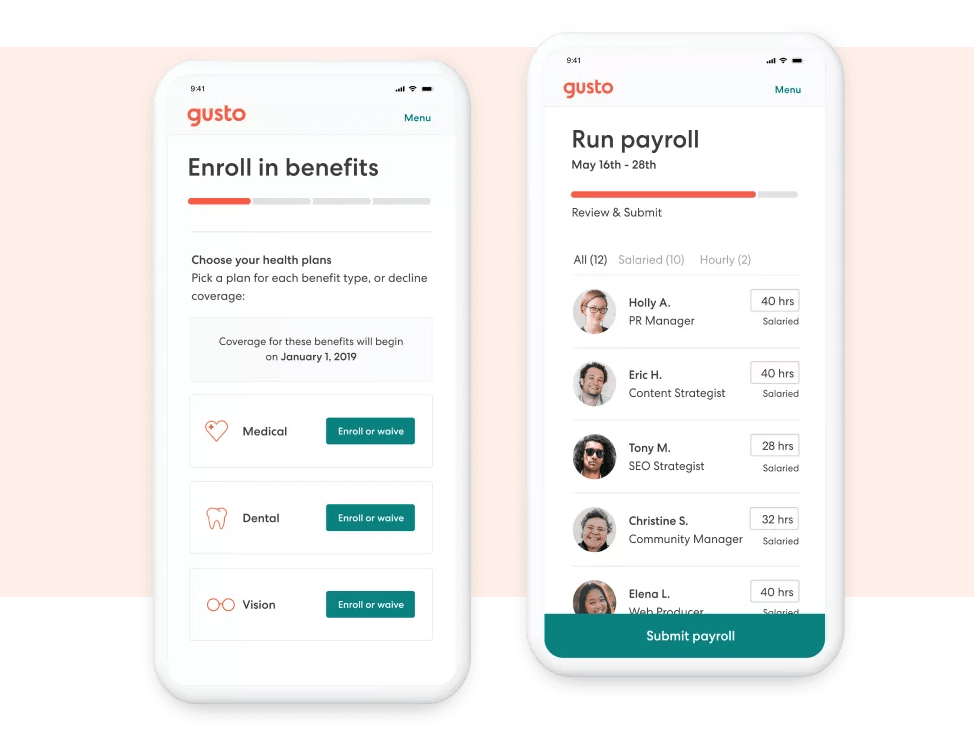
Whether they sign in from their laptop or the mobile app, employees get a super-friendly interface and access to loads of self-help resources.
“I really had actually no complaints about it,” said the founder of a nine-person marketing agency. He received a lot of complaints about their prior system, describing it as “not as easy to use” and “a little bit more confusing.”
With Gusto, he said, “It’s been way better than expected as far as [the employee portal] goes.”
Gusto is welcoming to the point of almost being cheesy. There’s a dancing piggy bank and plenty of digital high-fives for tasks like completing your annual enrollment. But those tasks are incredibly important (ask any employee who missed the open enrollment window) and the tangible benefits of having an HR platform as engaging as Gusto cannot be overstated.
As a restaurateur told us, the simple design of the platform allows his employees to answer their own questions.
“You can get all the answers without having to send the flag up the chain,” he said. “That’s going to save a lot of unnecessary time that managers usually have to deal with week after week.”
And it’s more than just finding efficiencies. The restaurateur has seen a decrease in turnover, crediting Gusto in part for the high employee retention.
“They love the fact that if there is any discrepancy, it’s quickly resolved and processed,” he said. And errors are few and far between. “It just makes for a very consistent, steady atmosphere, even in the current social climate.”
The back end is just as good as the front end. You don’t need any formal HR experience to set up your company. Gusto walks you through the nuts and bolts, even sending the occasional timely reminder.
“I actually have someone starting today,” the restaurateur said when he talked to us. “And, sure enough, without even setting a reminder or anything, [Gusto] was like, ‘Hey, remember when she gets there, let’s go ahead and complete the I9, and that way you don’t have to worry about it anymore.’”
Without Gusto, he said he wouldn’t have thought to do it until his accountant hassled him at the last minute. He would have had to call his new worker at some random hour to make sure she could receive her first paycheck. Talk about avoiding a bad first impression.
Things like reimbursements are a walk in the park. You can set recurring reimbursements, bulk edit to do a bunch at once, or make it right with an employee who had to float a purchase on their own personal card.
“They can submit the receipt,” said the founder, “[and] boom, we reimburse them—nice and easy.”
One reason a lot of people chose Gusto was its time tracking capability. It used to be desktop-only, but now you can clock in and out directly from the app, which is a welcome improvement.
One manager who used the system told us it hardly requires any training, “maybe two to three minutes for someone who’s never seen it before.” She really appreciated the ability to edit hours easily, and that all edits were tracked.
Potential Drawbacks of Running HR with Gusto
Gusto is great at what it does, but there are some HR tasks that it just doesn’t handle. In the future, I could see more built-in tools for recruiting, performance management, and so on being added.
For now, you’ll have to rely on integrations to extend Gusto’s functionality. For companies that know they need more than what Gusto can do on its own, it makes sense to seriously consider whether they’ll still be able to centralize HR work for their department and employees.
You could wind up having to add tools to an ever-increasing stack. Don’t get me wrong, it’s a great solution in its own right, it’s just that there are ways to handle a lot more of HR under one umbrella with Namely, Zenefits, and even BambooHR, to some extent.
But this wasn’t a pressing need for most of the people I talked with. They tended to have fewer than 50 employees and Gusto’s ability to deal with the basic back office stuff was more than enough.
“If I wanted to be really tough,” said one user trying to come up with a criticism of the platform, “some of the reports are hard to find and they’re not necessarily that pretty.”
For some of the other users I talked with, the limited reporting and lack of performance management would have made Gusto a non-starter. Generally, though, these users were at much larger companies or those that had become complex while keeping a lower headcount.
Your typical company just starting out is not going to hit Gusto’s limits for the first couple of years. And when they have to jump ship, they’ll be moving to a product that would have made no sense to use for the first few dozen hires.
Gusto Pricing
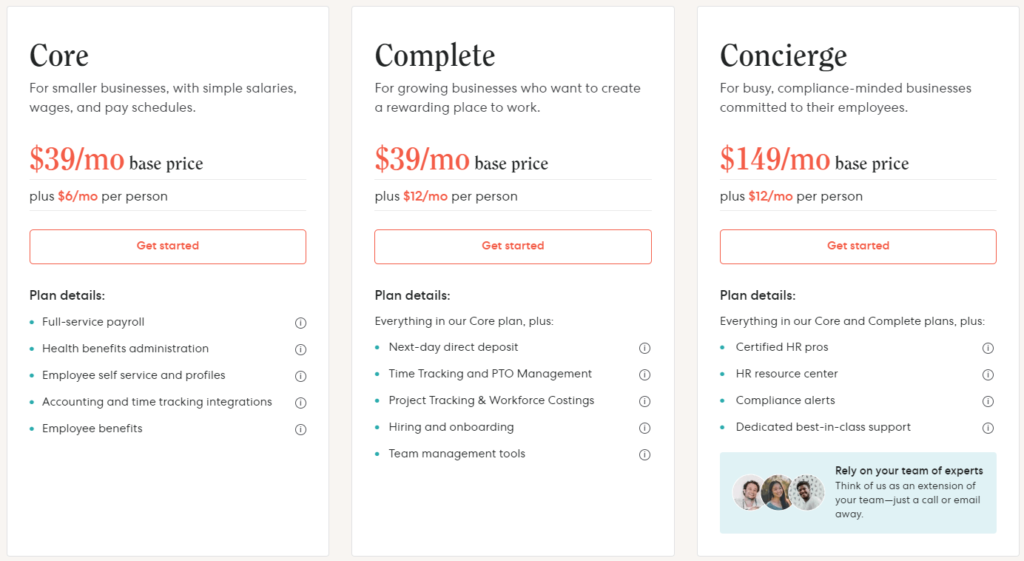
There are three packages offered by Gusto, as well as add-ons for things like Workers Compensation Insurance , 401(k) plans, and so on. Each package includes a base price, and a cost per person:
- Core — $39 per month + $6 per person
- Complete — $39 per month + $12 per person
- Concierge — $149 per month + $12 per person
Core is very good for the price, as it covers payroll, benefits administration, and Gusto’s best-in-class employee self-service portal. One notable thing it does not cover is PTO policies. For a really small business, this will be fine.
Upgrading to Complete gives you the PTO, tools for onboarding, and some better reporting and organization tools that become important once you have more than a handful of employees.
Even if you think you can get by with one of the other plans, my recommendation is the Concierge plan. This is where you get a dedicated customer support rep, phone service, and a number of other HR resources to help you steer the ship. You also get access to domain experts in compliance, tax law, and employee relations.
Yes, it’s a steep jump in the monthly base price compared to Complete, but the added customer support is worth it for companies just starting out.
There’s a ton of ways to screw up basic HR tasks at a new company. I can back that up with personal experience. Getting timely answers can prevent fines, touchy paycheck problems, and save you hours of re-doing things the right way.
We found a range of comments about Gusto’s customer service in the public reviews. Some people were really frustrated. In our interviews, though, we encountered only happy customers.
“They get back to you real quick,” said one user of Gusto’s support team.
Another said that she wished Gusto’s customer service could handle everything in her life.
“Every time I have had an issue or been confused,” she said, “they have been so patient and helpful.”
The simple explanation is that these folks were getting the premium customer support on the Concierge plan. I recommend you do, too, unless you’ve got the in-house experience to deal with thorny issues on your own.
Why We Ranked Gusto at #1
No HR software seems to make small business problems disappear quite like Gusto does. It completely handles the basics of payroll, benefits, and HR administration. All of that is consolidated in a system that’s easy for employees and admins to master.
While it probably has some limits that would annoy midsize companies, organizations just starting out aren’t going to run into any problems. Every service Gusto provides is more than good enough for your first 50 or so hires.
“Honestly, it was pretty mind blowing,” said one small business owner. “Having gone through really terrible payroll cycles in the past, where I have multiple data entry sources everywhere, to all of a sudden be like, ‘Oh, you know what? We’re actually good to go.’”
Bottom line: Startups and small businesses are good to go with Gusto.
#2 – Namely — Best HR Software for Mid-Sized Companies
- Unify all your HR tasks
- Made for mid-sized businesses
- Detailed reporting
- Keeps supporting your continued growth
>> Compare Quotes
Namely is my top choice for leaders looking to take their organization past the bounds of small business. Up to this point, they may have managed with a number of different tools to handle various HR tasks. It’s harder now and scaling with this setup would be excruciating.
With Namely, companies that have outgrown small business solutions don’t have to fill the gap with yet another tool—or spring for an enterprise solution that costs seven times what they’re paying now.
“We just needed a single platform to simplify things,” the CEO of a 200-person company told me, “but it also needed to be effective.”
They had four separate systems before switching to Namely.
“Managing those different systems was kind of a job in and of itself,” he said. They went from four systems to one with Namely, and he said “it absolutely handled everything.”
At a glance, Namely provides tools for:
- Employee database
- Payroll
- Benefits administration
- Time off management
- Onboarding
- Time and attendance
- Performance management
- Recruiting and applicant tracking
- Company news feed
This is a much greater range than most of the other platforms I’ve recommended. You’ll have more control and ability to customize with each one.
For example, whereas BambooHR offers fairly templated performance review options, Namely lets you create custom fields and pull reports on any metric you track.
Between the pre-built dashboards, point-in-time reporting, and the ability to build ad-hoc reports, Namely gives your administrators and leadership a more nuanced view of what’s happening in your organization.
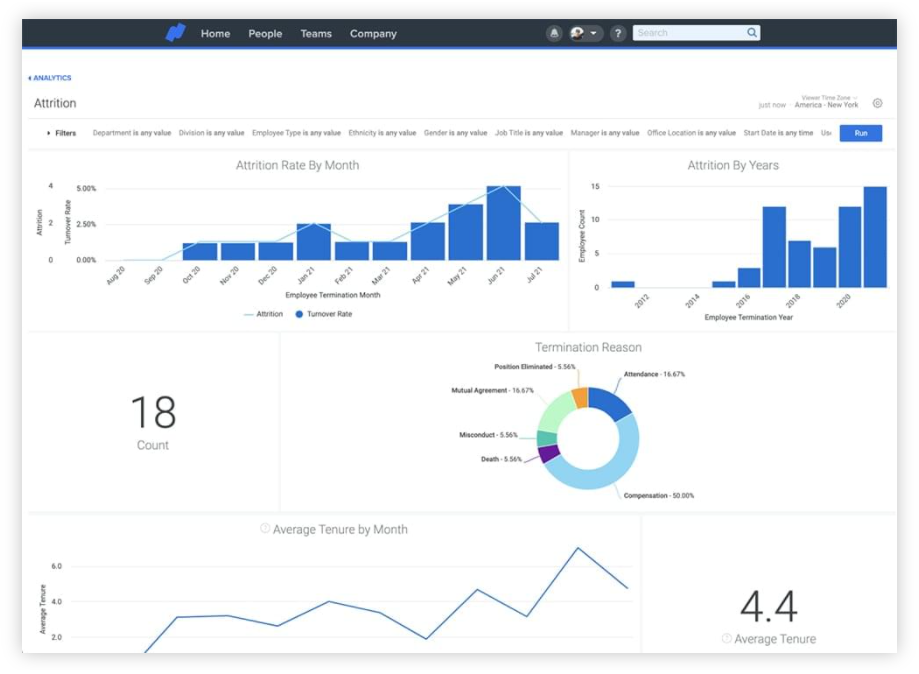
While this might be more analytical firepower than a company of 10 needs, midsize organizations need that level of visibility.
What I really liked was that this depth did not come at the expense of ease of administration or employee access.
The CEO reported that there was virtually no training necessary to get his team ready to use it. All his team did was make sure that their data was transferred.
“It’s just flip the switch and go,” he said.
The CEO found that his organization saved hundreds of hours each year after streamlining the open enrollment process.
“It was so easy because the end user goes to one location, everything is done.” Previously, it had taken upwards of four hours for employees to complete a process that took about 10 minutes with Namely.
I’m not going to dwell on where Namely meets the core HR challenges—just know that it does really well.
Instead, I want to look at where it steps away from the other lighter solutions, mainly in the depth of reporting and performance reviews.
A director of operations at a 50-person company really appreciated being able to create reports for anything she wanted and make those reports available for other managers.
“It’s just easy to drag and drop, add new fields, remove fields, create duplicate reports, and then customize it,” she said.
As an HR veteran who’s used multiple platforms over the years, she valued the fact that she never had to call customer support to make her own customizations.
“Namely makes that [really] easy,” she said. “I don’t really need their support. I mean, maybe twice a year I reach out for support with them.”
For the CEO, the customizable reporting was critical for his initiative to promote diversity, equity, and inclusion in the workplace. And for the company as a whole, Namely allowed him to visualize exactly where the company stands demographically, and make the necessary adjustments in recruiting.
“The data has been extremely useful for the human side of [our organization],” he said.
And, regardless of your hiring priorities, Namely makes onboarding and new hire self-administration a breeze.
“It’s a really great first impression with new hires,” a director of human resources told me. She found that people could help themselves without trouble, which meant they weren’t coming to her office for a change of address or other basic tasks.
Namely users were also very happy with the performance management features.
You’re not sending basic employee surveys or templated reviews—Namely lets you capture the information you need, and it’s automatically tracked and available to employees and managers.
“It had a really nice cascading goals feature that automatically got those pulled at the annual reviews,” the director of operations explained.
This made the whole review process “transparent across the company,” and allowed employee goals to be aligned to team and company-wide goals.
Moving out of the startup stage required the CEO we spoke with to find a platform that gave administrators the tools to help employees develop and retain talent.
“Namely had all the functionality we actually needed,” he said, and it “scratched the itch on so many different things.”
From deep performance management and reporting to supporting better hiring and employee development initiatives, Namely helps your HR operations leave the shallow end of small and early stage businesses and join the rest of your operations in the teeming waters of the midsize world.
“As we expanded and the business got a little bit more complex,” the CEO realized, “you just have to take care of people better.”
I’m just scratching the surface here, but these examples highlight the gulf between what you can do with Namely and the more limited ability of something like Gusto.
Potential Drawbacks of Running HR with Namely
Namely is going to work really well for fast-growth businesses, but it isn’t really built for more than 1,000 employees. The company seems really committed to the “midsize” bracket. It would just be a shame to have to jump ship simply because you outgrew it.
“It’s perfect for us, and we can continue to grow off of it,” said the CEO, who has about 250 people in his organization right now.
He wasn’t worried about Namely losing its usefulness because he figures the company won’t grow past 500 employees in the next ten years. But he wasn’t sure that Namely would perform as well at the enterprise scale.
Some users did report that the performance review process could get “a little clunky.” Writing things into the system during the review, for example, always seems to require extra clicks and then you’re losing track of information.
“It’s not like it’s bad,” one user said, “It’s just not as easy as I think it can be.”
It was hardly universal, as another user had rigorous expectations for performance management and came away completely satisfied.
One thing that might be a turn-off for novice HR folks is that you have to submit cases to customer support, you can’t just reach out by phone. Generally speaking, the users we talked to were very happy with the response times and quality of assistance, even though it is a ticketed system.
“They’re very communicative,” said one user. They rarely relied on support, but, “it’s nice when we do reach out, we get a quick response or they answer it live time.”
Most people we talked to were in the same boat—they only needed customer service infrequently.
It’s no coincidence that all the Namely users we interviewed were HR professionals. The CEO no longer ran any of the day-to-day HR tasks, but he’d been the one who saw the need, identified Namely, and pushed for the system’s use.
I doubt Namely would have been such a breeze to implement or required so little training if someone brand-new to HR was at the helm. With other platforms, I talked with a lot of founders and owners, people running HR out of necessity rather than by design. Namely would not be my choice for them.
As good as it is for a small business that’s ready to make the jump to midsize, it might not be the software to get you to that point.
Namely Pricing
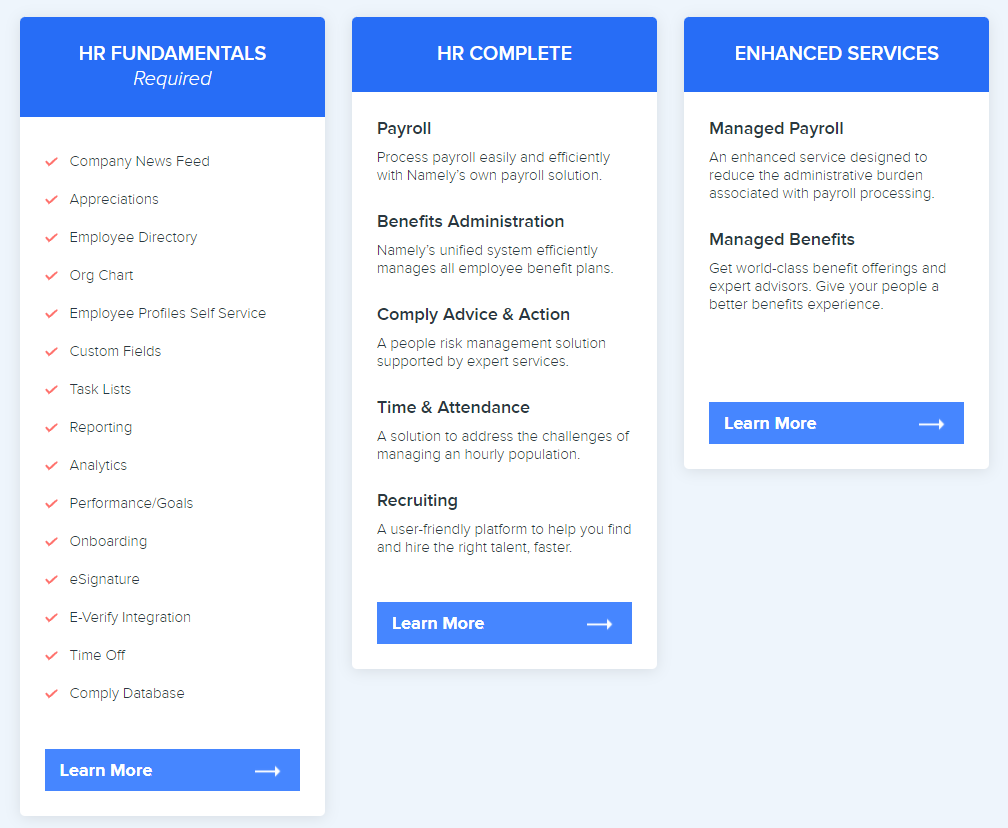
You’ll have to get in touch with the company for pricing, but everything is built off the HR Fundamentals base package, which is a very powerful HRIS.
From there, you can extend software by purchasing some or all of the HR Complete extensions. Working with Namely, you’ll come up with a custom package that fits your needs, just bear in mind that HR Fundamentals does not include major components like Payroll and Benefits Administration.
You can also outsource payroll and benefits responsibilities with Enhanced Services.
There are no pricing tiers with Namely. You’re not getting a better version because you pay more. Once you pay Namely for a service, you never need to upgrade to access a premium feature.
Why We Ranked Namely at #2
Namely is fantastic HR software for companies that are trying to do more than the simpler platforms allow, while remaining easy to use for employees and employers alike.
It’s deeper and more flexible, providing midsize businesses the tools they need to increase visibility and develop talent at an constantly growing organization.
Zenefits is another good option for companies in this position, but Namely definitely has the edge in terms of easier implementation and more responsive customer service.
“It actually works the way they say it works,” said the CEO.
Bottom line: Namely offers midsize companies the depth they need—without the headaches, high costs, or clunky interface that come with similarly powerful HR software.
#3 – BambooHR — Best Support For A Small In-House Team
- Perfect for modernizing your HR
- Handles complex tax compliance
- Robust applicant tracking system
- Helpful app for employees & admins
BambooHR is a great option for HR teams that still lean on paper records or hate their current HR software.
It offers a good deal more range than Gusto, which I think works better for businesses starting fresh. Administrative teams that have taken on recruiting or performance reviews can manage everything from BambooHR, whereas Gusto users would have to rely on integrations, if available.
BambooHR covers these HR bases in its platform:
- Employee database
- Payroll
- Benefits administration
- Onboarding
- Time and attendance
- Time off management
- Recruiting and applicant tracking
- Performance Management
What we discovered in our research was that some of the tools aren’t as feature-rich as folks would like, but it handles the fundamentals extremely well.
We spoke with one HR manager at a church with 70 employees. As a nonprofit, they have some unusual tax and payroll stipulations. She worried about implementation and whether there would be issues, but said transitioning to BambooHR “has been a great experience.”
So far, she said she saves about 15 to 20 hours a week from the system they were using before.
Syncing payroll with onboarding, for example, allows their system to recognize different classifications of staff.
“If someone’s a class five, they need this [particular] benefit packet sent out,” she said. “Or, class threes and fours clock in, so then we are able to attach the different time keeping steps as well.”
BambooHR’s built-in applicant tracking system (ATS) holds its own with standalone products like Freshteam. Whenever you have a team as opposed to a single HR person, there are just way more cracks that candidates can fall through.
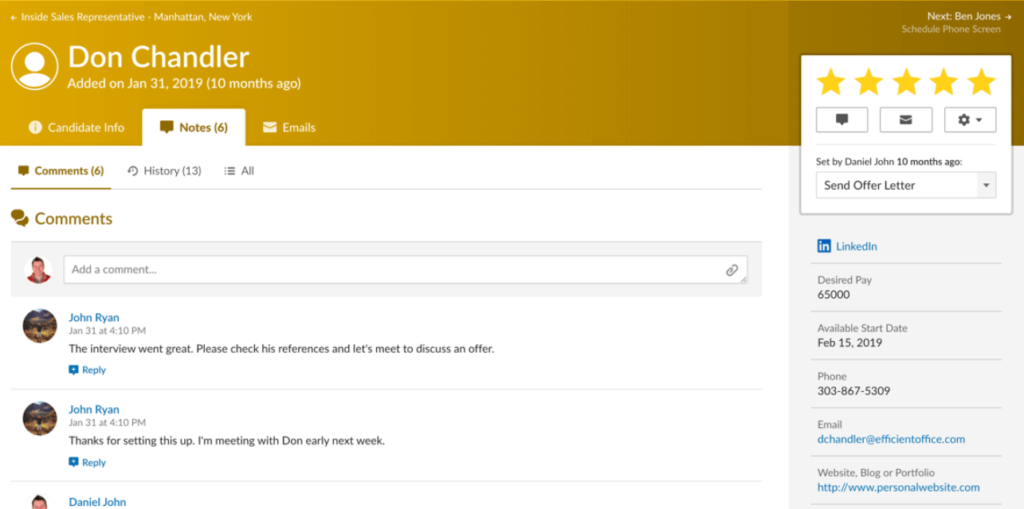
BambooHR takes all the guesswork out of getting recruitment right. You can loop anyone in and control their permissions, plus get feedback from other stakeholders without anyone accidentally deleting a record.
There are integrations with major job boards and the big social media platforms. That information is all tracked in a single pipeline. While users noted limited reporting with performance management in BambooHR, they didn’t have the same concerns about the ATS.
Where it really stepped away from the competition was the phone service included with BambooHR Advantage plans.
“I always speak to a human,” explained one HR manager. At most, she waited two or three minutes, “but they’re usually right on. [It’s a] very knowledgeable and friendly staff.”
This kind of service is incredibly valuable, especially for small teams that are encountering new challenges as their company grows.
Hiring employees in new states or expanding their benefits packages can get really tricky. Avoiding mistakes in these areas—that may only come up months later in an audit—with a simple phone call is incredibly valuable.
Employees seem to really like the platform, too. One HR manager told us that 90 percent of what her employees need to do can be accomplished from the app. She said the app has come a long way in the four years she’s been using the product.
The more employees can take care of on their own, the fewer calls they need to make to their HR manager. No one has to get pulled away from screening candidates to answer a basic W2 question ever again.
Potential Drawbacks of Running HR with BambooHR
Bamboo does the basics well. But where it offers a lot of range, it doesn’t have the same depth as other options, like Namely.
You may not be able to carry over all of your existing processes perfectly because some aspects of BambooHR are fairly templated.
Now, this may lead to a better system than you had before or it can be frustrating. One HR manager we talked to who considered BambooHR, but ended up going with Namely, cited the limited number of questions you could ask on a performance review.
Another BambooHR user told us she was tempted to switch because of the limited reporting. One example she recalled was not being able to get her finance team a report with the breakdowns they needed.
In the end, she stuck with BambooHR. The alternate system they piloted was a little more heavyweight for reporting, but her employees hated the interface and wanted nothing to do with it.
You may hit limits with BambooHR if you have an ambitious performance review process or need to dive deep in the analytics. The tradeoff is a simple system that unites all of HR for a typical small business.
One area where we saw a lot of complaints in the public reviews was payroll. From our interviews, we discovered how this problem had been fixed, though many of those reviews remain online.
Formerly, BambooHR used an integration with Execupy, and it seems like there were a lot of problems. Now Bamboo uses TRAX payroll and it’s working a lot better for BambooHR users.
One user we spoke with, who has been with BambooHR throughout the transition, said that they have no payroll errors now, whereas the old payroll processing system had consistent issues.
BambooHR Pricing
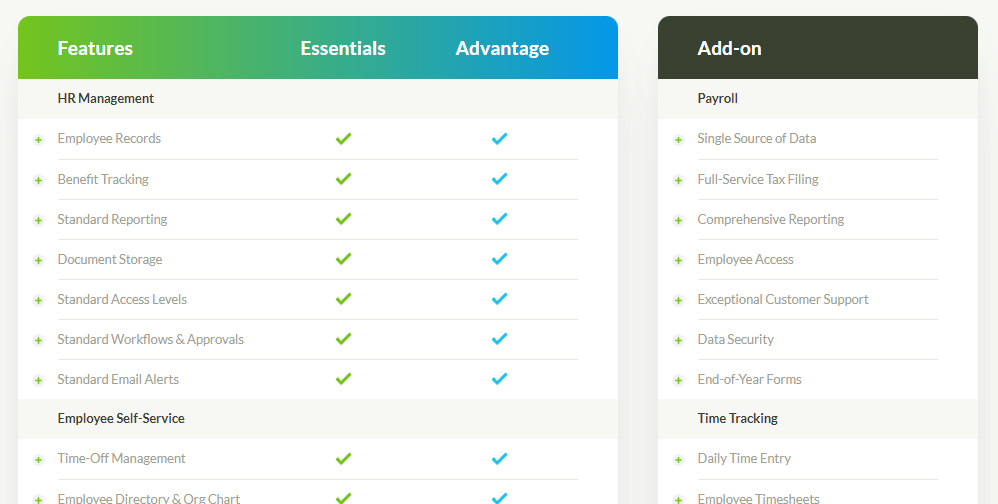
You’ll have to get in touch with BambooHR for pricing, but they offer two clear-cut packages and a number of add-ons.
The Essentials package is aptly named, and gives your back office what it needs to stay organized.
It’s a barebones option that serves as a single source of employee information. Unlike Gusto’s entry-level plan, it includes PTO management, which may be of interest to those looking for a basic HRIS that addresses that persistent need.
I highly recommend the Advantage plan for any company that hires regularly. You get the ATS, onboarding tools, e-signature capturing, and the ability to create custom workflows. Small teams will be able to tick every box that much quicker.
The add-ons are Payroll, Time Tracking, and Performance Management. These are each full services where you get all of the features without needing to upgrade your plan entirely.
So, BambooHR has a lot of range, but you can also just pay for what you need.
Why We Ranked BambooHR at #3
We ranked BambooHR highly because it’s welcoming to employees and completely centralizes a wide range of HR tasks within a single platform. Small to midsize businesses that don’t need especially complex approval workflows, reporting, or performance management features are going to find everything they need.
“It’s a simplified but very knowledgeable platform,” said one satisfied BambooHR user. It condensed work on her end and helped employees navigate on theirs.
Like Gusto, BambooHR is an intuitive platform with easy implementation. It’s going to be a better fit for companies that want to tie in recruiting and applicant tracking.
Bottom line: BambooHR is a great tool for empowering a small team. They’ll be able to coordinate HR across the whole employee lifecycle—from the first meeting as strangers on a job board to offboarding someone who’s been at the company for years.
#4 – Zenefits — Best for Hands-On HR Administrators
- Deep reporting customization
- Great for supporting HR pros
- Improve performance management
- Helps you foster a better workfplace culture
>> Compare Quotes
Zenefits gives administrators a lot more flexibility to run HR the way they want. The tradeoff, though, is that Zenefits is going to take longer to launch than some other small business HR software.
It’s still an easy-to-use platform for employees, but there’s more of a learning curve for admins.
For companies with experienced HR professionals on staff, the extra legwork to get Zenefits off the ground will be well worth it. Your HR teams will be able to take a more active role in employee development and provide much more detailed information to leadership than they ever could with something like Gusto.
You’re free to customize the platform to fit your business. Collect whatever data you want, build your performance review process from scratch—you don’t have to squeeze your company into a general use template.
Just look at the HR areas where Zenefits can assist or improve your capabilities:
- Employee database
- Payroll
- Benefits administration
- Onboarding
- Time off management
- Time and attendance
- Performance management
- Well-being management
- People Hub (social network)
There’s very little missing from the platform, and you can extend its capabilities through integration with recruiting, verification, accounting, and other software.
One user I talked with used Zenefits for several years while working for a payroll company. “You can use it as an all-in-one,” they said, “or you can take pieces.”
They obviously didn’t need payroll, but it served them well for everything else.
Now, Zenefits doesn’t let you pick the exact services you want—you’ll be choosing between base packages and several add-ons—but the folks I talked with had no trouble making it fit their needs.
An HR manager we spoke with used Zenefits at three very different companies, all with good results.
“It just makes my role so much easier,” she said. Currently, she oversees a bit under 50 employees. As a self-described “HR department of one,” she really appreciated how well Zenefits simplified administration.
Employees are responsible for entering their information during onboarding. She has to review it once, and then it “feeds into all these other locations seamlessly, simultaneously.”
Instead of having to manually enter employee information into multiple platforms, Zenefits provides a consistent system of record. “It just omits errors and saves a lot of time,” she said.
There are a lot of similarities to Gusto and BambooHR, but the major difference is that Zenefits is much better able to capture and report on information.
“You can create custom fields in an employee’s profile,” one VP of Operations told us. “And as long as there’s a field, Zenefits will report on it.”
In other words, you get to decide the important metrics you want to track.
For someone brand new to HR, the increased capabilities might be needless or overwhelming. But in the hands of a capable administrator, Zenefits can have a much greater impact on employee development and workplace culture than the lighter options.
Rather than fit performance reviews into a template or survey, you can create the questions and types of questions you want.
“Maybe it’s multiple choice, an essay question, or yes/no,” said one HR manager. There’s a lot more flexibility, though you can select from pre-built review templates for peer and supervisor reviews if you want.
You can set goals or let employees set their own. Everything is visible to managers, who can schedule review cycles and track progress toward individual, team, and company goals.
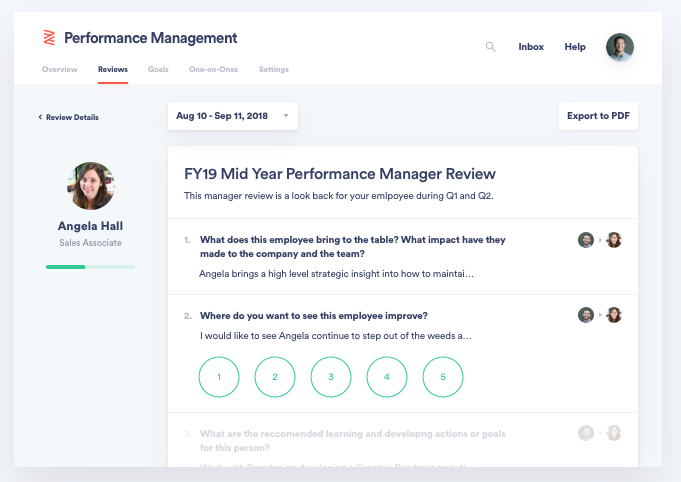
All the performance data is tracked and any criteria you’ve decided to include can be reported on. Employees can fill out reviews straight from their account, with everything going into a single, consistent record.
Managers also get tools to support one-on-one meetings with their direct reports. These are all things you can do in other platforms, but it often requires software integration.
Zenefits works well because employees aren’t intimidated by it. Filling out a performance review is easy, and they can do it from wherever they want on the mobile app. The director of operations appreciated the “autonomy” her employees had, which was extremely important in their ability and desire to buy into the platform.
Like the other user-friendly platforms, Zenefits excels at getting employees to handle routine tasks on their own. You can also give them access to People Hub, a 21st century company intranet that functions like a social feed. They’ll see new tasks there, which administrators can share with specific teams or departments.
There’s simply a broader range of ways HR can use Zenefits to help their company thrive. I’ve only glossed over what’s available. If the limits of the lighter tools are causing you concern, I’d recommend taking a closer look at Zenefits.
Potential Drawbacks of Running HR with Zenefits
Whereas I think just about anyone can start administering HR with Gusto, Zenefits works better in the hands of an HR professional.
“It’s really good for people who kind of know what they’re doing,” said one HR manager who has used Zenefits for over seven years. It took some time for her to find her way around, and even now, “I’m still learning so much.”
Because there’s more you can do, it’s going to take more time to learn. This won’t necessarily be a drawback for people who have experienced HR folks on staff, but for novice administrators, I’d think a lot about whether the increased control is going to be worth the potential backend difficulties they’ll experience.
No one was thrilled about the time it took to implement Zenefits.
“It’s like when you get your kitchen remodeled,” one user said, of their experience, “Whatever the contractor tells you, double that.”
This same user really loved the platform, but the implementation and integrations were “not as smooth as suggested.”
Another user said, “It’s so simplified once it’s all integrated, but you have to invest some time.”
This is true of any software, but with options like Gusto and BambooHR, where easy deployment really does seem to live hype, you have to be sure that you want to go the extra mile.
Investing in Zenefits is worth it for companies that need detailed reporting and performance management. But if that’s not a big deal, the other options might be just as good with a lot less stress.
What complicates these issues even further is that Zenefits customer support is not a highlight for most of the users we spoke to. One experienced no real issues, but the others reported extremely sluggish response times. Two to three weeks was typical for standard issues, but even urgent problems might take 24-48 hours.
One HR manager told us they wound up getting late fees based on a Zenefits error and a lack of timely assistance. In this case, Zenefits “ate the late fees for us” because it was their mistake. “So I do think that is representative of good customer service,” shea said, “It’s just the turnaround time that is slow.”
Another user really wanted some help with regards to pandemic tax credits, and she simply couldn’t get in touch with Zenefits until she wrote a frustrated review online. It shouldn’t take that to get a response.
For companies that don’t have a lot of in-house HR experience, Zenefits lack of support is something you should think about. There are ways to plan ahead and work around it, but you might be better off with BambooHR if you want to keep things simple, or Namely if you need a deeper feature set.
Zenefits Pricing
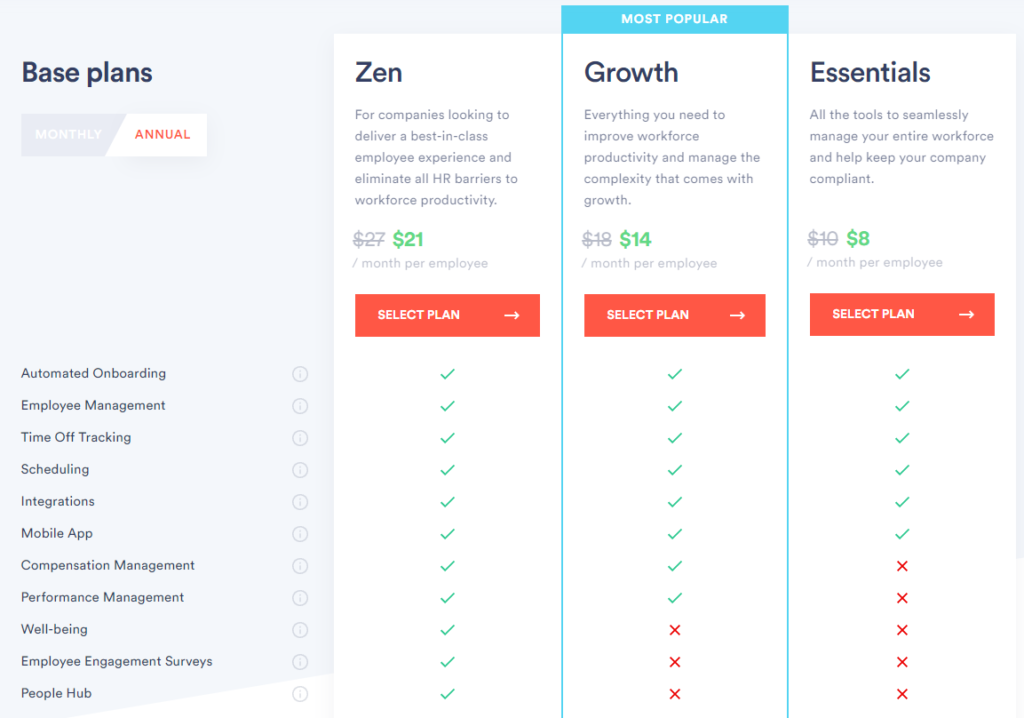
Zenefits offers three different plans. The price is all-inclusive, billed per employee each month. You can save a little by signing up for a year instead of paying monthly. The annual rates for each plan are:
- Essentials — $8/month per person
- Growth — $14/month per person
- Zen — $21/month per person
Payroll service can be added to any plan for $6 per month per employee. Other add-ons include HR advisory services and benefits administration via your own preferred broker. If you elect to use one of Zenefits broker partners, benefits administration is free with annual plans.
The Essentials plan is a rock-solid HRIS. You’ll have access to all the onboarding and PTO features that don’t come with Gusto’s entry level plan. Zenefits also includes native time and attendance tracking in this entry-level package, which is a premium feature on nearly every other platform.
Growth includes the performance management features that users reviewed so highly, as well as more tools for payroll reporting and compensation management.
The Zen plan adds more arrows to the quiver of administrators and company leadership looking to encourage a connected workplace culture. There’s a company social network (People Hub), where people can share announcements, big wins, and important jobs to be done. You’ll also get tools for conducting employee surveys and promoting well-being.
I highly recommend taking a deeper look at Zenefits premium plans if you are encountering problems with workplace cohesion. Any of these tools will assist a remote workforce every bit as well as people in the same physical office.
“We have to pay for it and it’s not cheap,” said one user who loved the platform. “But when we looked at the price of what we’re paying [another company] to do our payroll, tax, and accounting stuff, it just was kind of a no-brainer, even with the cost.”
Why We Ranked Zenefits at #4
Zenefits is welcoming for employees and empowering for admins, but you need to be thoughtful about change management and ensure that your staff is up to the challenge.
You have a lot more control over what you can track than the lighter systems, but it comes with a steeper admin learning curve and more involved implementation.
I really recommend it to companies who have at least one person with experience in HR on staff. Their presence softens the tradeoffs you have to make with deployment and support. Once you’re up and running, they’ll be able to take full advantage of the deep toolkit.
We ranked it lower than Namely, which also has a lot of depth, because the implementation and customer service were rated much higher by the people we talked with.
“It’s such a great interface.” said one user, “I just think that people should go in with a little bit more realistic expectations than what Zenefits presents.”
Bottom line: If you want to take HR seriously, Zenefits will help you go further than a lot of other user-friendly platforms, but be prepared to do a lot of troubleshooting on your own.
#5 – Freshteam — Best for Shortening Your Time To Hire
- The best ATS on the market
- Also helps with onboarding & PTO
- Syncs with dozens of job boards, calendars, & video solutions
- Free for 3 job postings
If you’ve got the basic HR tasks under control but want to level up your recruitment process, Freshteam is one of the first options you should check out.
It’s unique among my recommendations as it won’t centralize all of your HR. There’s no built-in solution for payroll or benefits management, for example.
The reason Freshteam made the cut is that it unites a basic human resource information system (HRIS) with a powerful recruiting and applicant tracking system (ATS).
For some companies, this is all the centralization they need. Maybe they’ve had payroll and benefits locked down for years and don’t want to switch everything up just to start hiring better.
Here are the main areas the Freshteam platform covers:
- Employee database
- Recruiting and applicant tracking
- Onboarding
- Time off management
As you can tell, this software is completely focused on recruiting, screening, onboarding, and managing talent once you’ve signed it.
In the words of the founder of an accounting software company who used Freshteam, “There are only a couple of use-cases and the good part is they [handle them] very well.”
You can extend the platform, but all of the integrations are in service of recruiting. There’s no opportunity to tie in accounting software, for example, but you will be able to integrate Freshteam with a range of calendars, job boards, video conferencing software, and assessment portals.
You’ll also get tools to create an on-brand career site that looks good on mobile. Or, you can simply create a careers tab on your company Facebook page.
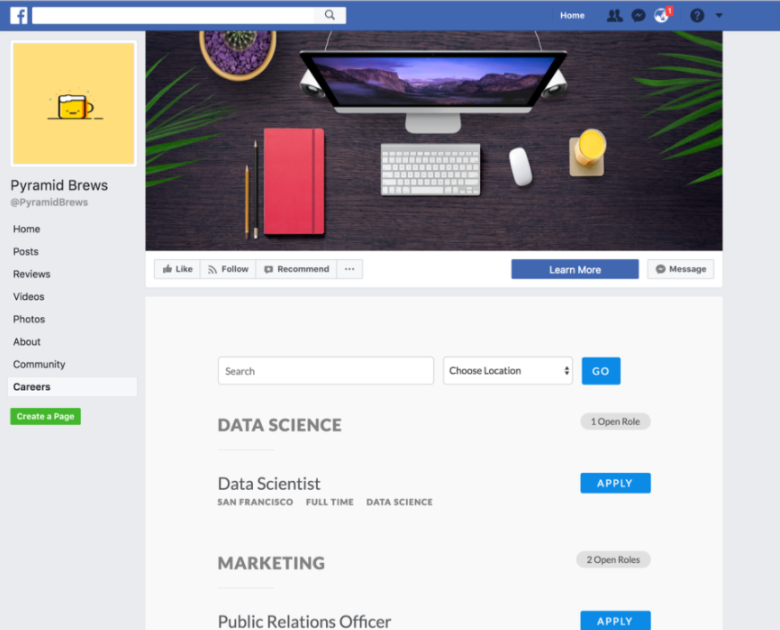
Do you already use LinkedIn, Indeed, or ZipRecruiter? Freshteam integrates with those, too. You’ll always know how you found candidates and be able to track them throughout the hiring process.
Create custom workflows to move candidates through each stage. Parse resumes, tag candidate profiles, sync your inbox, and schedule emails to go out at the opportune time.
There are a lot of ways to streamline your hiring process. Though the interface is really easy to navigate, it’s not so templated as to constrict teams from collaborating on their own terms.
And it’s easy to keep candidates notified of just where they are in the pipeline with simple automations you can trigger at key milestones.
Of course, all of this information is tied into a single employee database. Here you can manage PTO, create org charts, and manage all employee records. Employees will be able to upload their own documents to the platform, allowing HR to send a simple reminder rather than having to track people down.
From onboarding to offboarding, your administrators are approving employee information, not having to enter it themselves.
“Their onboarding flow is good,” said one user. “We hire a lot of interns and short-term freelancers. So in those cases, it really helps us to have that onboarding checklist and offboarding checklist.”
Freshteam works best for people that want to improve their recruiting efforts and centralize basic employee administration.
As one very happy Freshteam user noted, “We never wanted a very highly complicated system, so it suited our requirements perfectly.”
Potential Drawbacks of Running HR with Freshteam
This is not a product you can use to centralize all of HR, so I don’t recommend it for that purpose. It’s great for recruiting, onboarding, and handling the very basics of employee records, like tracking PTO.
If you are looking to unify time tracking or payroll, it’s simply not the solution to use.
You’ll be able to pull reports, but they’re limited because so much of HR isn’t under the Freshteam roof. “I wish they had more payroll-related stuff, but they don’t,” said one user.
I see no drawbacks using Freshteam as designed, but you cannot really extend its ability. Yes, it’s part of the Freshworks platform, but those other tools are focused on delivering CRM, sales, and customer support solutions.
You can’t really build out a full HR solution starting with Freshteam as your base. As one user said, “If business owners are looking for a comprehensive solution that includes payroll, accounting, and all that stuff, then Freshteam may not be suitable for them.”
Freshteam Pricing
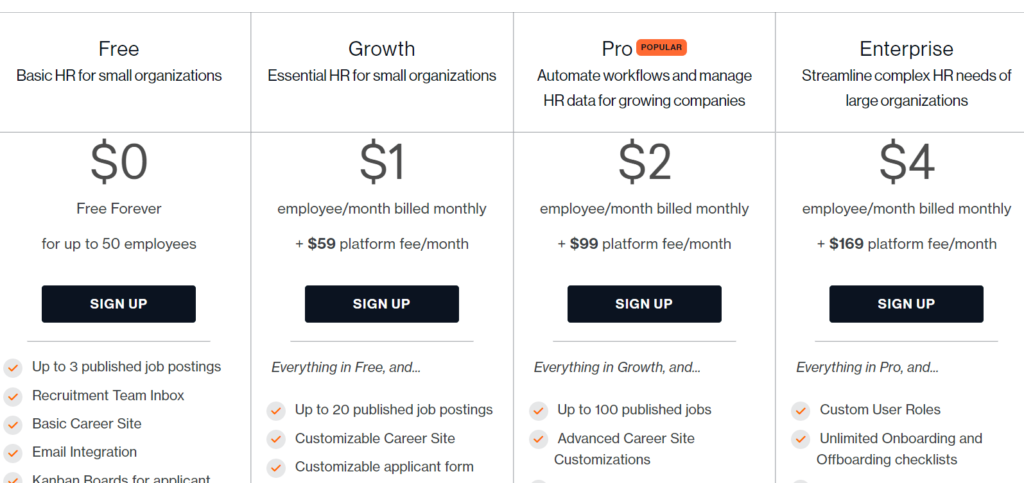
Freshteam offers a Free forever plan that’s good for up to three job postings and three tiers of paid plans. Each has a base price along with a per user price:
- Growth — $59 per month + $1 per person
- Pro — $99 per month + $2 per person
- Enterprise — $169 per month + $4 per person
The price will be slightly higher if you opt to pay month to month instead of signing an annual contract.
The Growth plan is limited to 20 published job postings, and comes with most of the features I’ve described in this review.
You really have to read the offerings carefully, as there’s a fine-grained segmentation of what you can do with each platform. With Growth, for example, you are limited to two time off policies that apply to the organization.
The major stuff is all there, but you might find limits on your ability to accommodate a bunch of different employee roles or set up complex workflows.
Companies with a single office will be fine with Growth, but if you have multiple offices in multiple regions, you may wish to upgrade.
With Pro, there’s a lot fewer restrictions on what you can tweak. You can publish up to 100 job postings and you get access to recruiting via social media.
Customizing job descriptions or employee accounts is also a lot more freewheeling. You get unlimited PTO policies, work-week configurations, holiday calendars, and such.
Enterprise plans come with a dedicated account rep and tools to handle recruiting at scale. Create as many different types of onboarding checklists as you need and build out custom user roles to ensure that staff are only viewing specific information.
Why We Ranked Freshteam at #5
Freshteam is a tool we think a lot of HR departments will find extremely useful for recruiting and onboarding. As an ATS and basic HRIS, it checks all the boxes, but users looking to consolidate their HR stack will need to look at the other options.
But, if you’re a small company without HR software and finding good candidates has been a challenge, why not test-drive the free forever version of Freshteam?
Companies that are happy with their existing HR processes, but need something to supercharge hiring will also do well with Freshteam. They won’t have to reinvent the wheel just to get a better system for tracking applicants.
Bottom line: Freshteam is a powerful tool for recruiting talented employees and managing them once they’re onboard. It’s not an all-in-one HR solution, but it doesn’t pretend to be.
How We Chose Which HR Software to Review
You don’t have to be an HR pro to make a good decision about the software your company needs. It probably helps, but these reviews should serve as a good roadmap to someone looking for HR software for the first time.
Our team focused on solutions that work for small to midsize businesses. Enterprise HR software buyers need to get references from other companies in their industry, have a long procurement process ahead of them, and there’s no way we can speak to those buyers in any but the most general way.
With HR software for SMBs, you’ve still got a range of options. We further narrowed our list down to software that centralizes HR in a meaningful way.
At our company, having payroll, benefits, and basic administration in the same system has been great. It saves everyone a ton of time and energy—no more logging into multiple accounts to accomplish small tasks.
So we excluded a lot of great standalone payroll services, Human Resource Information Systems (HRIS), and other potential solutions that are great, but have to be added to an existing tech stack.
With one intriguing exception, we limited our list of top picks that can handle all of today’s core HR responsibilities within a single system. For us, that meant:
- Employee database
- Onboarding
- Payroll
- Benefits Administration
- Tax and Compliance
Some of our top picks are stronger in some areas than others, but core HR is covered. Things like PTO, managing employment docs, getting the checks out in time—you’re set with any of these options.
Where certain software is exceptional, or limited in an annoying way, I’ve called it out in the reviews.
We also looked for products that did more than just core HR, and you’ll find that many of our recommendations can also provide:
- Time and Attendance
- Applicant Tracking
- Recruiting
- Performance Management
You don’t have to use (or pay for) all of these services. Providers offer different packages or completely customized setups in order to get you the services you need.
As you need more services, you can add them to the same centralized system. You’re not trying to get different software to play nice together or finding that you need to transition to a new HR software (oh, the horror!) because you want to conduct performance reviews.
It’s easy enough to match your needs with a company that offers the correct suite of services, and I’ve bulleted out a consistent menu of what each provider offers. This should help because terminology varies, and one provider’s talent management is another’s recruiting.
Yet you need to do more than check the right boxes. The quality of each of these services is what really matters. How do they work in practice?
To find out, we spoke with folks who are actively using the software today. They’ve bought in and entrusted their paychecks, personal information, and a lot of time into these products.
Demoing platforms is a solid idea to get a proof of concept, but we really wanted to get people’s thoughts on relying on these platforms for one, two, four years down the line. That’s what matters and that’s what we strove to find out.
How We Reviewed Each HR Software
Over the course of three weeks, the Quick Sprout team identified active users of HR software in a variety of industries and company sizes. After making contact and verifying that the person was an active user at a real company, we arranged a short interview to talk about their experience.
Conversations ranged widely. We spoke with office managers, solopreneurs, VPs, and founders doubling as their own HR department. Some owned a few store fronts, others ran offices of 40, 70, or 400 people.
They didn’t all have the same challenges. I had to take everything our research team discovered and put it in perspective.
Of course the person who switched from a pen and paper system to BambooHR is ecstatic about their experience. Their “flawless” rating is valuable, but it’s not an apples-to-apples comparison with the critical feedback of seasoned HR managers. They had much higher expectations and nuanced needs.
The takeaway for me is that you simply can’t judge HR software against a single standard. Any consistent metrics fall apart when you step back to consider how each feature works for different size companies, in different industries, with different types of employees.
So how do you judge your options?
After talking with a lot of active users and reflecting on their feedback, their judgment ultimately resided in how well the product met their expectations. Did the HR software really impact their organization according to the standard set by the provider?
What earned a high rank in my book is captured perfectly by a CEO who’s been using Namely for a little over a year. “They didn’t oversell and overpromise,” he said. “And the promises that they said they were going to have in this system are exactly what has taken place.”
The standards we used from our reviews came from each provider. What do they promise the end-user experience is going to be like?
By talking with folks that are using this software today, we could get an accurate reading of how these options measure up to their advertising copy. Now you can, too.
What We Learned Choosing the Best HR Software
After weeks of research and hours of interviews, I had to distill our findings down to something readers could actually use to frame their decision.
Below you’ll find six key considerations.
The first four are going to be helpful for people looking to satisfy the core HR tasks.
The last two deal with some of the add-on and advanced features that come with premium HR software plans.
I recommend reading the whole thing, even if you only need the core HR features.
Spending Money on HR Pays Dividends
One of the first things we noticed was that price matters a lot less than getting something that really works. Any savings you see from shoehorning your HR into a low-cost option is going to evaporate as soon as there’s an issue.
A founder we spoke with ran into serious trouble this way.
“Here’s where I made a big mistake,” he said. “I was thinking, ‘Why don’t I just go with the absolute cheapest thing that fits our needs and that’ll work?’”
He did, and his team encountered problems with everything.
Payroll errors, state and local tax confusion, and surprise fines for things he thought were taken care of. Eventually that provider went out of business, forcing him to switch midyear.
That’s something of a nightmare scenario, but over-focusing on price can blind an owner from getting something that’s actually going to work.
“I did all that to save $100 bucks a month, or whatever it was,” that same founder said. “It was just a huge distraction.”
The flipside is that now he’s paying a reasonable amount for Gusto and his problems have disappeared. He did a back-of-the-envelope calculation during our call and estimated that Gusto saves his company around $300 per month. They pay less than that for Gusto.
You can absolutely find cheaper HR software than what I’ve recommended. I’d just be cautious, and remember that a well-built, fully-functional solution like Gusto is going to pay for itself with savings in time and labor.
“If we weren’t paying for them, we’d have to use something else,” the founder said. They certainly couldn’t handle payroll and HR themselves. “It would be way too advanced and complicated, sending off the tax payments. That would take a ton of time.”
And, at a larger company, where the software costs a lot more than $300 per month, the savings from working with the right tool are even more dramatic.
A CEO did a time study after implementing Namely and found that open enrollment went from taking users four hours to complete to 10 minutes.
The time wasted with their previous solution was “immense,” and it was so painful to go through the process every fall with several hundred employees. Namely wasn’t cheaper than what they had, but this small process improvement saved them hundreds of hours across the organization each year.
I’ve included some affordable HR solutions, like Gusto, Zenefits, and Freshteam, but not because of their price. These are all-around great platforms that can offer a good deal because their software is so much sleeker than older systems that were born in the paper age.
New and smaller companies can benefit from the simplicity of these platforms, and perhaps pay less than whatever they’re spending on HR right now.
Giving Employees Control Gives Administrators a Break
From onboarding to retirement, you can give employees control over their HR affairs that used to require a call to the office. Let them simply log into an online portal or mobile app and manage their own affairs: paid time off, address changes, benefits, contributions, and more.
I wanted to find out how much employees were actually taking advantage of this control.
After all, the more your employees can manage on their own, the less time your staff spends handling routine paperwork. Everything is tracked in a single system, and administrators can approve that PTO with a click and never have to dig up someone’s W-2 ever again.
Little things end up taking a lot of time.
“So let’s say an employee wanted a copy of their paycheck to send to a landlord,” a director of operations said, describing their old system. “They would have to come to us, we manually generate the copy, and then we send it to them.”
That system worked for 10 people, but as they grew to 50, she said it became overwhelming.
With Zenefits, she loved the “autonomy” employees had to make changes in the app. “It helps HR, from an HR standpoint, that we don’t have to go in ourselves and do all that work.”
To get this win/win, the interface has to be accessible. Don’t underestimate the value of employee engagement when it comes to HR software. The more they can handle on their own, the happier they will be and the less your HR people have to do.
The onboarding experience plays a huge role in starting this symbiotic relationship with the HR software.
An HR manager who used BambooHR at her 70-person nonprofit, was considering switching to another software with more robust reporting. The new tool lacked BambooHRs welcoming feel, however.
It was “the cosmetic part,” she said, along with the less user-friendly app, that led them to stop implementation because “our employees were very dissatisfied with it.”
A restaurateur using Gusto for two of his locations felt like the “the ease of use for new hires or anyone trying to adjust to things,” actually played a part in his low turnover.
Working in restaurants has been anything but stable since the pandemic. Both he and his staff highly value the “consistent, steady atmosphere” Gusto provides on the back end.
21st century employees are starting to expect 24/7, anywhere access to any type of account, including HR. Provide this using cloud-based software so that the connection and data are secured by your provider. The best HR software will let you get ahead of the curve and reclaim valuable hours of administrators’ time.
Customer Support Has to be Dependable
How much help are you really going to get implementing your new HR software? As you search your options, you’re going to see a lot of “stress-free” and “simple” transitions advertised.
For Gusto and Namely, this is the exact experience users reported. As one Gusto user told us, he feared the pain that he expected to come with the transition to a new system, “and there wasn’t any.”
A Namely user with more than 200 people in his company described a “really impressive” implementation. There was “very little startup time” and the transition “was seamless in getting it started and adopted.”
He credited the intuitiveness of the platform—on the frontend and backend—as making it easy for users to pick up.
“There was literally no training,” he said. “Well, I wouldn’t say literally, but it was mostly no training.”
BambooHR and Freshteams received similar, if not quite as enthusiastic, praise from users about how painless the deployment process was.
With Zenefits, on the other hand, users reported a more lengthy implementation time than they’d been told. One woman described a “difficult” transition that involved a lot of manual entry. It actually pushed their start date past January 1, which was definitely not ideal.
I would suggest dedicating some brainpower to change management no matter what you choose to implement. You want to have a plan, and definitely don’t want to switch during the middle of the year. If you must, switch at the beginning of a new quarter to limit the amount of historical reporting you’ll have to juggle.
But customer service cannot fall off the map once you’ve paid and their sales team has moved on to new leads. When you have a burning tax question, it can’t wait.
While the platforms I’ve recommended give employees and admins access to a ton of great information, there are some HR questions that have to be kicked to customer support.
BambooHR and Namely really excelled, according to our research and interviews. Most of the other platforms were still good (this factor is very important), but these two stood out in their own way.
With BambooHR’s Advantage plan, you get access to phone support. From what we found in our research, this is the real deal. One HR manager we spoke with was able to connect with a human within a few minutes every time.
When you are limited to submitting tickets for customer service, as you are with Zenefits, it can really slow you down.
“They do solve problems,” said one user about Zenefits customer service. “Resolutions are made and answers are given. It’s just that the timeline is slow.”
Namely stood out for its quick response times despite being a ticketed system. A director of HR who’s used Namely for years said that the customer service was always pretty good, though sometimes she felt like she knew more than the agent on the other end.
Now, she explained, your tickets are automatically routed to the agents who know the most about that part of this system, “So that has definitely improved over time.”
Bear in mind that the sterling customer support tends to show up with premium plans. BambooHR’s Essentials package, for example, doesn’t include the amazing phone support I just described. Gusto is similar in that the more expensive Concierge package is the only one that comes with live support from HR experts.
This gets back to the idea that spending a little more to get phone support, a dedicated rep, or on-demand HR advisors can wind up saving you a lot of money, time, and stress.
I highly recommend taking this route if your company doesn’t have the in-house HR experience to catch the curve balls that come their way. Companies with a knowledgeable department may not be impacted so much by slow response times.
Payroll Should Not Be A Stressor
I encountered zero users who had a problem with their payroll and tax filings using the HR software I reviewed. Zero. This includes folks who have employees in multiple states, as well as those who used time tracking features.
So if you are having even the slightest trouble with the payroll side of HR, I would highly recommend checking out one of the options on my list. You’ll be outsourcing all the tax headaches every pay period.
One Gusto user described how reassuring it was to “be sure that everybody’s taken care of, so you’re not scrambling on a Thursday night, making sure everybody has their check on Friday.”
Gusto has a lot of flexibility. You can run payroll as many times as you like, setting up four, two, or next-day deposits. Employees can also download Gusto Wallet, a digital banking app that lets them access earnings and manage their money.
The reporting is Gusto is not as strong as with Zenefits or Namely. There are 16 pre-built reports and three types of customized reports you can build yourself. If you want to get your finance department detailed breakdowns of payroll as it relates to other aspects of your company, Gusto might fall short.
BambooHR has more powerful reporting than Gusto, but it was still an area where users were hitting limitations. You do have the ability to build and automate your own workflows in BambooHR, which can streamline the process of running payroll.
For your basic payroll, Gusto is as easy as it gets. If you have more reporting or workflow needs, one of the other options may suit you better
Check the Depth of Performance Management
Are you looking to offer your employees a career, and not just a job? Do they see a future with your company or are raises and promotions something that happens when it happens?
Up to this point, I’ve been focusing on aspects of HR software that are important to any type of buyer. The last two takeaways deal with functionality that is crucial to businesses trying to take the next step.
“We were a startup company that had grown into a certain level of maturity,” a CEO who switched to Namely told us. In his eyes, they needed to start treating people better. “So this past year, we have been really big on setting individual goals and targets.” For him, Namely provided everything they needed to make it easy for employees to engage in the process.
If you really value performance reviews, employee feedback, and want to report on that information in a detailed way, I’d recommend Namely and Zenefits. These platforms put you in the driver’s seat.
An HR director who used Namely said she was very happy with her ability to make the performance review process map to their workplace. “Our ability to have questions around our core values, and then have it automatically collect that person’s annual goals for that year,” was one of the chief reasons she chose Namely.
“It has all the levels of approval I want,” she said, from employees, to managers, to the manager’s manager. Everyone is notified automatically, and she can pull reports after to see the distributions.
“I didn’t have to try to change our process to fit the system, the system could fit our process,” she said.
BambooHR and especially Gusto give you a much more limited toolkit. Freshteam doesn’t do performance management at all.
I spoke with one BambooHR user, for instance, who wished for more control over the performance review template.
“It’s pretty limited,” she said, citing the inability to alter the standard questions and add more than four additional questions.
Compare this to what we heard from a VP of Operations who used Zenefits extensively for performance reviews.
“I think it’s great,” she said. “You can create types of questions. Maybe it’s multiple choice, or maybe it’s an essay question, or yes or no. And you can have as many questions as you want.”
Still BambooHR does have a few different options to gather feedback, set goals, and track performance. Gusto is limited to employee surveys. While these can be helpful for getting a temperature read of where people are at, none of the Gusto users I talked with were trying to do anything serious with performance management.
Performance management isn’t going to be important to every company. But if it’s important to you, look for HR software that lets you build out the performance management system you want.
Trying to squeeze into the lighter options probably isn’t going to work well, especially at scale.
Make Built-In Reporting More Useful for Your Needs
How much control do you have over what the platform tracks? And from the data you’ve chosen to collect, what kinds of reports can you pull?
My recommendations offer a spectrum of reporting customization: from the canned reports of Gusto and Freshteam, to the more flexible reporting in BambooHR, onto the fully adaptable metrics of Zenefits and Namely
This becomes really important for companies that need to comply with unusual regulations, expect to be audited, or have goals that require more complex reporting than what the basic features can handle.
“One of my big topics is diversity, equity, and inclusion,” a CEO who uses Namely told me. “We can see the data,” he said, “So if we’re trying to be more diverse, are we actually doing it or not?”
Because he’d centralized all aspects of HR into Namely, the company was able to identify their current demographic trends and shift recruiting accordingly.
“It’s so easy that I can see it in a quick snapshot, and I can start making decisions off of that,” he said.
Another Namely user was very happy with the HR analytics for helping her respond to questions about affirmative action and benefits. She could find any information she needed about her staff, from any date in time, in a matter of minutes. During something like al 401(k) or EEOC audit, this was invaluable.
Zenefits will let you create custom fields where you need them: tables, employee profiles, and performance reviews.
And, as one user noted, “As long as there’s a field, Zenefits will report on it.” This really puts you in the drivers’ seat when it comes to reporting.
Bear in mind that super technical reporting is going to take some time to set up. Gusto has fairly limited reporting capabilities, but there’s no legwork required to pull an employee summary, workforce costing report, or start digging into various aspects of payroll.
For a lot of the folks we spoke with, Gusto’s reports were all they needed. It worked because they weren’t expecting nor needing much customization.
BambooHR allows you to do slightly more—you can create custom fields and reports. And, because it’s got an ATS and more performance management features, you’ll be able to get more visibility into hiring and employee development, which is a blindspot for Gusto.
Still, the users we talked with weren’t blown away by their ability to track unique information in BambooHR. One office manager said that they contemplated switching HR software simply to be able to download different kinds of reports, though she noted that there is a lot more flexibility now that BambooHR has switched to TRAX payroll.
For many companies, the canned reports of Gusto, BambooHR, and Freshteams (if you’re focused solely on recruiting) will be more than enough. But if you know you need more options for reports or the ability to capture customized information, you’re going to be much better served by Zenefits and Namely. They have deeper reporting capabilities that will work a lot better for more complex compliance demands or workforce initiatives.
Conclusion
Set your expectations high and don’t settle. It’s a great time to be looking for HR software.
My top picks have simplified the task of small business payroll and HR to a point that’s virtually unrecognizable from the slow, clunky systems it replaced. Here’s a quick recap of the best HR software today:
- Gusto – Best for your first 50 hires
- Namely – Best for businesses that have outgrown basic HR solutions
- BambooHR – Best support for a small in-house team
- Zenefits – Best for experienced administrators
- Freshteam – Best for shortening your time to hire
My recommendations are the result of speaking with active users about how this software is impacting their companies right now. They’re consolidating the number of tools they need to manage HR, saving everyone a ton of time, and providing company leadership with valuable insight about how to grow best.
If you are searching for a more standalone service to knock out a specific HR task, Freshteam can help with recruiting and employee management. You should also check out my other content about human resources, which cover a lot of specific use-case tools like:
- Best applicant tracking software
- Best background check companies
- Best business process management software
- Best HR outsourcing
- Best online payroll services
- Best time and attendance systems
from Quick Sprout https://ift.tt/3gwg6hk
via IFTTT
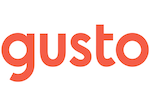
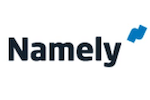
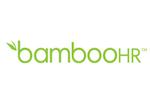
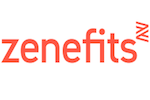
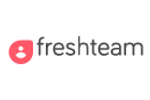
No comments:
Post a Comment